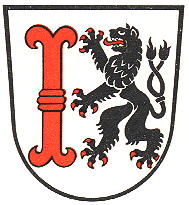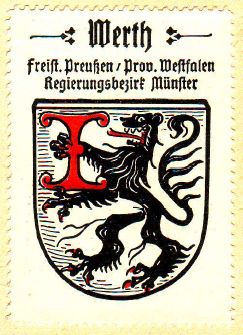Werth: Difference between revisions
Knorrepoes (talk | contribs) m (Text replace - "[[Literature" to "{{media}} [[Literature") |
Knorrepoes (talk | contribs) m (Text replace - "The arms in the Kaffee Hag albums +/- 1925 " to "The arms by Hupp in the Kaffee Hag albums +/- 1925 ") |
||
| Line 24: | Line 24: | ||
{|align="center" | {|align="center" | ||
|align="center"|[[File:werth.hagd.jpg|center]] <br/>The arms in the [[Kaffee Hag albums]] +/- 1925 | |align="center"|[[File:werth.hagd.jpg|center]] <br/>The arms by [[Otto Hupp|Hupp]] in the [[Kaffee Hag albums]] +/- 1925 | ||
|} | |} | ||
Revision as of 07:44, 21 November 2014
| Heraldry of the World Civic heraldry of Germany - Deutsche Wappen (Gemeindewappen/Kreiswappen) |
WERTH
State : Nordrhein-Westfalen
District (Kreis) : Borken (until 1974 Rees)
Incorporated into : 1975 Isselburg
Origin/meaning
The arms were officilly grantes in 1948.
The arms are derived from the oldest known seal of the city, known since 1442, in which the lion and the wall-anchor were seen separately.
The lion is derived from the arms of the Lords of the Leck, who founded in 1300 the village around one of their castles. The lion was first used on a seal from Folpert van der Leck in 1233. The wall-anchor is derived from the Lords van Culemborg (see also the city of Culemborg in the Netherlands), who acquired the estate of Werth in 1344. They were descendants of the Lords of the Leck (see Berkenwoude).
The arms were first were granted in 1840, but in these arms the lion was holding the anchor, see below. As this was not consistent with the old seals, the arms were restored in 1948.
| The arms by Hupp in the Kaffee Hag albums +/- 1925 |
Contact and Support
Partners:
Your logo here ?
Contact us
© since 1995, Heraldry of the World, Ralf Hartemink 
Index of the site
Literature : Stadler, K. : Deutsche Wappen - Bundesrepublik Deutschland. Angelsachsen Verlag, 1964-1971, 8 volumes.












